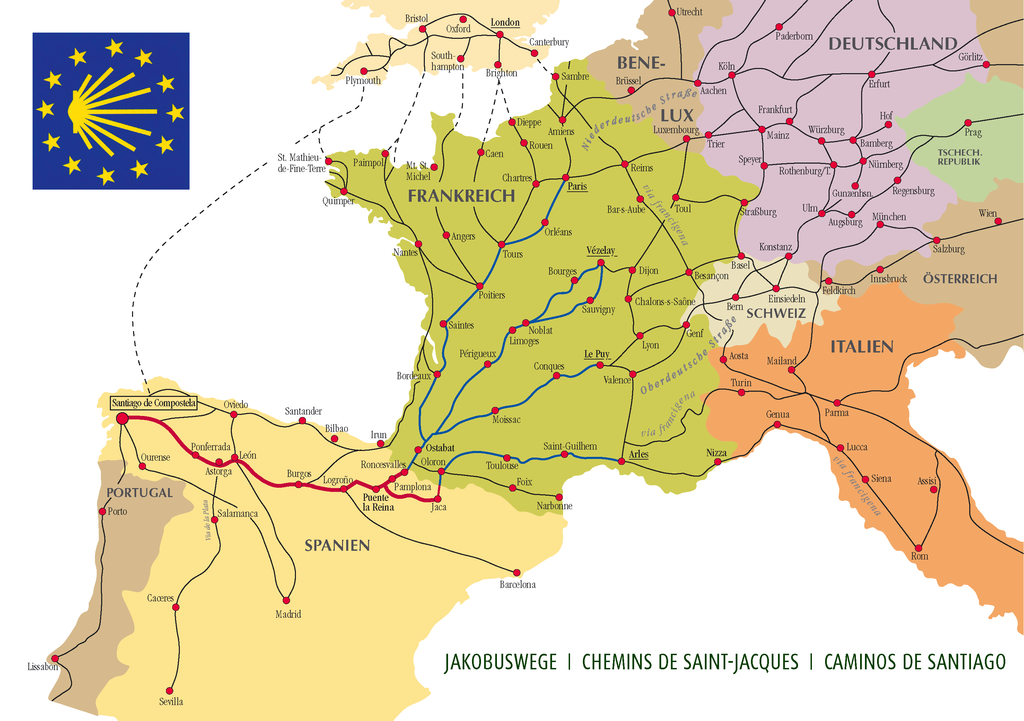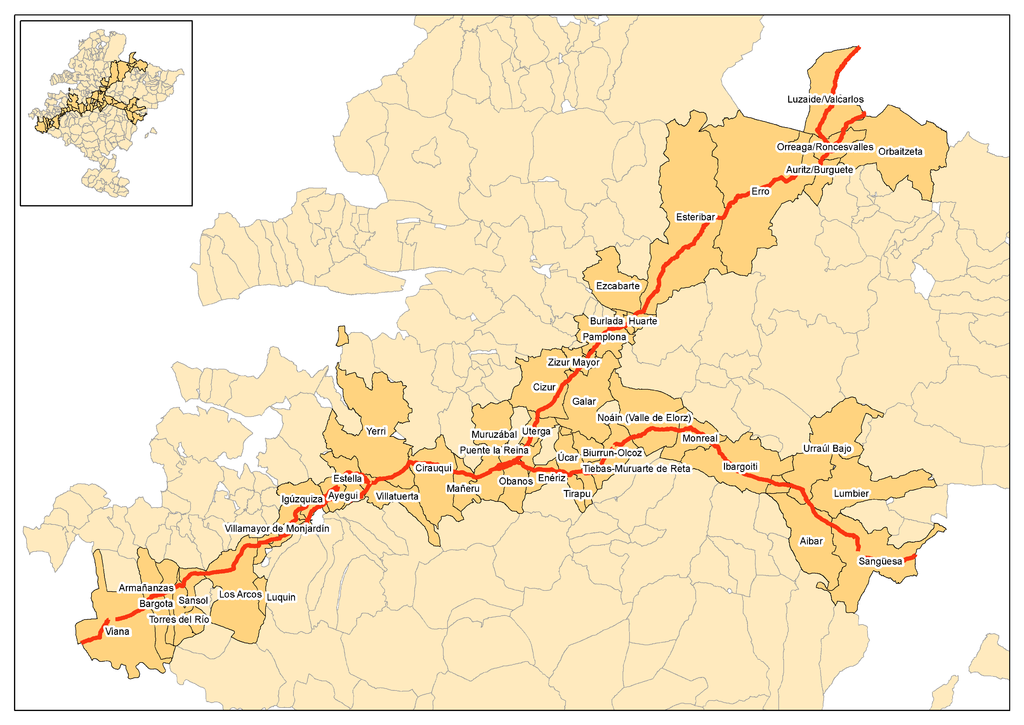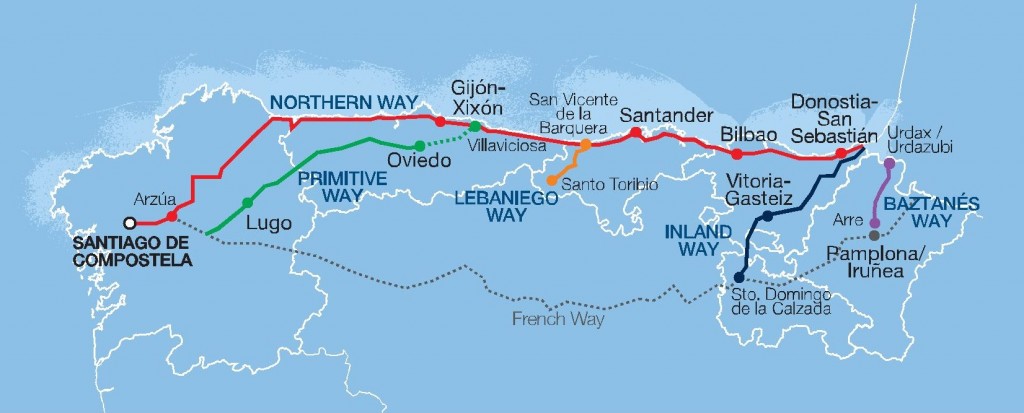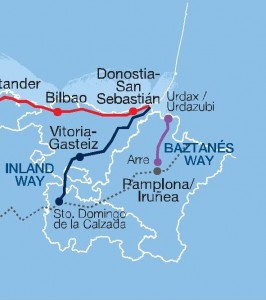[Euskaraz ] [Español ] [Français ]
Ways to Santiago through Euskal Herria / Basque Country: options for vegans
(Updated 5/5/2021) I write this little guide with the hope that it might be useful to all people who will do the Way of St. James («Camino de Santiago») and seek places with vegan options for food or to buy. There are not many places, but it’s a start The locations with information are markedblue.
The Camino de Santiago, also known by the English names Way of St. James, St. James’s Way, St. James’s Path, St. James’s Trail, Route of Santiago de Compostela, and Road to Santiago, is the name of any of the pilgrimage routes, known as pilgrim ways, (most commonly the Camino Francés or French route) to the shrine of the apostle St. James the Great in the Cathedral of Santiago de Compostela in Galicia in northwestern Spain, where tradition has it that the remains of the saint are buried.
The route attracted a growing number of modern-day pilgrims from around the globe. The route was declared the first European Cultural Route by the Council of Europe, and in 2015 «The Primitive Way», «The Northen Way or Coastal Way», «The Basque Inland Route» and «The Liebana way» were also named European Cultural Route ; it was also named one of UNESCO’s World Heritage Sites.
 De Manfred Zentgraf, Volkach, Germany – Manfred Zentgraf, Volkach, Germany, CC BY-SA 3.0, https://commons.wikimedia.org/w/index.php?curid=748316
De Manfred Zentgraf, Volkach, Germany – Manfred Zentgraf, Volkach, Germany, CC BY-SA 3.0, https://commons.wikimedia.org/w/index.php?curid=748316
Through the Basque Country pass the following routes:
French Way
The French Way (Spanish: Camino Francés) is the most popular of the routes. It runs from Saint-Jean-Pied-de-Port on the French side of the Pyrenees to Roncesvalles on the Spanish side before making its way through to Santiago de Compostela through the major cities of Pamplona, Logroño, Burgos and León.
The French way comes from two French branches that converge in Navarre:
1) French Way in Navarre from Saint Jean Pied-de-Port
Three of the main Jacobean routes in France the «Turonensis» the «Lemovicensis» and «Via Podiensis» converge in San Juan de Pied de Port. Then, it runs from Saint-Jean-Pied-de-Port on the French side of the Pyrenees to Roncesvalles
2) French Way in Navarre from Aragon
The Aragonese Way (Spanish: Camino Aragonés) comes down from the Somport pass in the Pyrenees and makes its way down through the old kingdom of Aragon. It follows the River Aragón passing through towns such as Jaca. It then crosses into the province of Navarre to Puente La Reina where it joins the Camino Francés.
French Way in Navarre:
 De Dhidalgo – Trabajo propio, CC BY-SA 3.0, https://commons.wikimedia.org/w/index.php?curid=2839959
De Dhidalgo – Trabajo propio, CC BY-SA 3.0, https://commons.wikimedia.org/w/index.php?curid=2839959
Tracing the route through the Basque Country:
| NAFARROA BEHEREA / LOWER NAVARRE | ZUBEROA / SOULE | ZUBEROA / SOULE |
| Via Turonensis |
Via Podiensis | Via Tolosana |
| Erango / Arancou | Ospitalepea / L’Hôpital – Saint – Blaise | |
| Donapeleu / Saint-Palais | Arüe – Ithorrotze – Olhaibi / Aroue – Ithorots – Olhaïby | Maule – Lextarre / Mauléon – Licharre |
| (At Donapeleu it joins the Via Lemovicensis) | (Follow by Izura – Azme / Ostabat – Asme) | NAFARROA BEHEREA / LOWER NAVARRE Donaixti – Ibarre / Saint – Just – Ibarre |
| Izura – Azme / Ostabat – Asme | (Follow by Izura – Azme / Ostabat – Asme) | |
| Main route |
Alternative to Ibañeta by Luzaide / Valcarlos | |
| NAFARROA BEHEREA / LOWER NAVARRE | NAFARROA BEHEREA / LOWER NAVARRE | |
| Donibane Garazi / Saint Jean Pied de Port | Donibane Garazi / Saint Jean Pied de Port | |
| Huntto (Eiheralarre / Saint – Michel) | Arnegi / Arnéguy | |
| Orisson (Uharte Garazi / Uhart-Cize) | ||
| Collado Bentartea / Col de Bentarte | NAFARROA / NAVARRE | |
| Main Route |
||
| NAFARROA / NAVARRE | Luzaide / Valcarlos | |
| Lepoeder / Col Lepoeder | ||
| Ibañeta / Roncesvalles Pass | Ibañeta / Roncesvalles Pass (Follow the main route: Orreaga / Roncesvalles, …) | |
| Orreaga / Roncesvalles | ||
| Auritz / Burguete | Entrance to Navarre from Aragon | Entrance to Navarre from Aragon. Alternative by Sigüés |
| Aurizberri / Espinal (Erroibar / Erro) | HUESCA and ZARAGOZA From France comes from Somport, Canfranc, Jaca to join the French Way in Sanguesa |
HUESCA and ZARAGOZA Puente la Reina de Jaca Berdún (Canal de Berdún) Sigüés Yesa |
| NAFARROA / NAVARRE | ||
| Bizkarreta – Gerendiain / Viscarret – Guerendiáin (Erroibar / Erro) | NAFARROA / NAVARRE | Javier |
| Lintzoain / Linzoáin (Erroibar / Erro) | Zangoza / Sangüesa | Zangoza / Sangüesa |
| Col de Erro | Ledea / Liédena | (Follow by entrance to Navarre from Aragón) |
| Zubiri (Esteribar) | Irunberri / Lumbier | |
| Larrasoaña (Esteribar) | Nardoze / Nardués (Urraulbeiti / Urraúl Bajo) | |
| Akerreta (Esteribar) | Aldauate / Aldunate (Urraulbeiti / Urraúl Bajo) | |
| Zuriain (Esteribar) | Izko / Izco (Ibargoiti) | |
| Irotz (Esteribar) | Abintzao / Abínzano (Ibargoiti) | |
| Zabaldika (Esteribar) | Getze Ibargoiti / Salinas de Ibargoiti (Ibargoiti) | |
| Atarrabia / Villava | Elo / Monreal | |
| Burlata / Burlada | Iharnotz / Yarnoz (Noain – Elortzibar / Noáin -Valle de Elorz) | |
| Iruña / Pamplona | Otao / Otano (Noain – Elortzibar / Noáin – Valle de Elorz) | |
| Zizur txikia / Cizur Menor (Zizur Zendea / Cendea de Cizur) | Gerendiain / Guerendiáin (Ultzama – Ulzama) | |
| Zarikiegi / Zariquiegui (Zizur Zendea / Cendea de Cizur) | Tebas – Muru Artederreta / Tiebas – Muruarte de Reta | |
| Erreniegako gainalde / Alto del Perdón | Arrizabalaga / Campanas (Tebas – Muru Artederreta / Tiebas – Muruarte de Reta) | |
| Uterga | Biurrun – Olkotz / Biurrun – Olcoz | |
| Muruzabal / Muruzábal | Ukar / Ucar | |
| Eneritz / Enériz | ||
| Obanos | Obanos | |
| Gares / Puente la Reina | (Follow by the main route: Gares / Puente la Reina, …) | |
| Mañeru | ||
| Zirauki / Cirauqui | ||
| Lorka / Lorca (Deierri / Valle de Yerri) | ||
| Bilatorta / Villatuerta | ||
| Lizarra / Estella | ||
| Aiegi / Ayegui | ||
| Iratxeko monasterioa / Monastery of Irache (Aiegi / Ayegui) | ||
| Azketa / Ázqueta (Iguzkitza / Igúzquiza) | ||
| Deio / Villamayor de Monjardín | ||
| Urbiola (Iguzkitza / Igúzquiza) | ||
| Urantzia / Los Arcos | ||
| Santsol / Sansol | ||
| Dorreaga / Torres del Río | ||
| Viana | ||
| From here the goes through La Rioja to Santiago de Compostela. | ||
The Northern ways:

Northern Way (Coastal way)
The Northern Way (Spanish: «Camino del Norte» or «Camino de la Costa») is the continuation of the «Camino de Soulac», walking the westernmost lands of France, and it runs from France at Irún and follows the northern coastline of Spain to Galicia where it heads inland towards Santiago joining the Camino Francés at Arzúa.
The Coastal path joins the French path at Arzúa, and from there, all the roads become one up to the final destination of Obradoiro square.
Tracing the route through the Basque Country:
| Main Route | ||
| LAPURDI / LABOURD | ||
| Baiona / Bayonne | ||
| Angelu / Anglet | ||
| Biarritz | ||
| Donibane Lohizune / Saint Jean de Luz | ||
| Hendaia / Hendaye | ||
| GIPUZKOA | Alternative by Errenteria | |
| Irun | Irun | Alternative by Astigarraga |
| Hondarribia | Oiartzun | Oiartzun |
| Lezo | Errenteria | Astigarraga |
| Pasai Donibane | Pasaia | |
| Pasai San Pedro | ||
| Donostia – San Sebastián | Donostia – San Sebastián | |
| Igeldo | ||
| Orio | ||
| Zarautz | ||
| Askizu (Getaria) | ||
| Zumaia | ||
| Itziar (Deba) | ||
| Deba | ||
| Olatz (Mutriku) | ||
| BIZKAIA | ||
| Larruskain (Markina – Xemein) | ||
| Markina – Xemein | ||
| Ziortza – Bolibar | ||
| Munitibar – Arbaiztegi – Gerrikaitz | ||
| Elexalde – Arratzu | ||
| Gernika – Lumo | ||
| Morga | ||
| Larrabetzu | ||
| Lezama | ||
| Zamudio | ||
| Bilbo / Bilbao | ||
| Kastrexana (Bilbo / Bilbao) | ||
| Barakaldo | ||
| Sestao | ||
| Portugalete | ||
| Arena / La Arena Beach (Zierbena) | ||
| Pobeña (Muskiz) | ||
| Kobaron (Muskiz) | ||
| CANTABRIA | ||
| El Haya – Ontón (Agüera) | ||
| From here the road follows Cantabria, Asturias and Galicia where it joins the French path up to Arzúa (A Coruña). | ||
Inland Way (Bayonne route, Alavés Way, San Adrian Tunnel route)
The Inland Way is also known as the Tunnel Route, the Basque Inland Route and the San Adrian Route. In the Early Middle Ages, when the Northern (Coastal) Way was subject to the Vikings’ skirmishes and Muslim presence and forays threatened pilgrims and trade routes in the borderlands, the Tunnel Way provided a safe road north of the frontier area.
Those who were aiming to cross the feared Pyrenees by the only pass on the coast, would go to the French town of Bayonne, and from there, they would follow the coastline until arriving at the frontier of the River Bidasoa. Then they had to cross the mountains and dales to then go through the epic San Adrian tunnel in the mountains of Aizkorri. Before joining the French Way, those who were on the pilgrimage would stop at the Old Cathedral in Vitoria. The road continues through La Rioja to Santo Domingo de la Calzada, where it joins the French Way.
Variant of Saiatz
This variant is in Gipuzkoa. Instead of passing by the riverside Oria goes by mountains that is on the left side. The variant leaves the way in Hernani and joins with him in Zerain, about two kilometers from Segura (keep in mind that some guidelines suggest that the main road passes through Zerain and others suggest this transit as an alternative). This variant takes its name from a historic Mayor, later Union and currently commonwealth, also known as Saiatz.
Tracing the route through the Basque Country:
| Main route | |
| LAPURDI / LABOURD | |
| Baiona / Bayonne | |
| Angelu / Anglet | |
| Biarritz | |
| Donibane Lohizune / Saint Jean de Luz | |
| Hendaia / Hendaye | |
| GIPUZKOA | |
| Irun | |
| Oiartzun | |
| Astigarraga | |
| Oria way |
Variant of Saiatz |
| Hernani | Hernani |
| Urnieta | Lasarte – Oria |
| Andoain | Zubieta |
| Villabona – Amasa | Zizurkil |
| Irura – Anoeta | Aia |
| Tolosa | Errezil |
| Alegia | Bidegoian |
| Legorreta | Santa Marina |
| Ordizia | Ezkio – Itxaso |
| Beasain | Ormaiztegi |
| Olaberria | Mutiloa |
| Idiazabal | Zerain |
| Segura | (Segura) |
| Zegama | Zegama |
| ARABA – ÁLAVA |
(follow by the main route) |
| Zalduondo | |
| Erdoñana / Ordoñana (Donemiliaga / San Millán) | |
| Agurain / Salvatierra | |
| Ezkerekotxa (Iruraitz – Gauna) | |
| Alegría – Dulantzi | |
| Burgelu / Elburgo | |
| Argandoña | |
| Arkaia | |
| Vitoria / Gasteiz | |
| Armentia | |
| Gormetxa | |
| Ariñiz / Ariñez | |
| Subillana Gasteiz / Subijana de Álava | |
| Villanueva de la Oca /Billa Oka (Treviño / Trebiñu) | |
| La Puebla de Arganzón / Argantzon (Treviño / Trebiñu) | |
| Burgueta / Burgeta (Treviño / Trebiñu) | |
| Estabelu / Estavillo (Armiñón) | |
| Route by Haro | Variant by Miranda de Ebro |
| ARABA – ÁLAVA |
ARABA – ÁLAVA |
| Estabelu / Estavillo (Armiñón) | Estabelu / Estavillo (Armiñón) |
| Berantevilla | BURGOS |
| Zanbrana | Miranda de Ebro |
| Buradon Gaztaga / Salinillas de Buradón (Bastida / Labastida) | Orón (Miranda de Ebro) |
| LA RIOJA |
Ameyugo |
| Briñas | Pancorbo |
| Haro | Zuñeda |
| Zarratón | Grisaleña |
| Cidamón | Cameno (Briviesca) |
| San Torcuato | Briviesca |
| Bañares | Quintanavides |
| Santo Domingo de la Calzada (where it joins the French Way) |
Burgos (where it joins the French Way) |
Baztanés way
Although the Baztanés Way begins in the French town of Bayonne, it enters Navarre through the district of Dantxarinea (Urdazubi-Urdax). This pilgrim’s route originally followed the traditional commercial routes that had travelled between Bayonne and Pamplona since Roman times, at least, and takes its name from the fi rst valley it passes through in Navarre: Baztán. And reaches the French Way in the Navarran town of Arre.
Tracing the route through the Basque Country:
LAPURDI / LABOURD
Baiona / Bayonne
Uztaritze / Ustaritz
Zuraide / Souraïde
Ainhoa
NAVARRE
Dantxarinea
Urdazubi / Urdax
Amaiur / Maya
Arizkun
Elbete
Elizondo
Lekarotz
Irurita
Ziga
Aniz
Berroeta
Almandoz
Lantz
Olague
Leazkue
Etulain
Burutain
Ostitz
Enderitz (Olaibar)
Olaiz (Olaibar)
Sorauren (Eskabarte)
Arre (Eskabarte)
At this point, it joins the French Way and it continues to Villaba, Burlada, Iruña-Pamplona.

More information:
Where to eat:
https://miuniversoverde.com/direcciones/where-to-eat-vegan/
Where to buy:
https://miuniversoverde.com/direcciones/where-to-buy-vegan/
Turism-Basque Goberment:
https://tourism.euskadi.eus/contenidos/recurso_tecnico/aa30_folletos/en_def/folletos/2011/santiago/Caminos%20del%20Norte%20INGLES.pdf
Wikipedia:
https://en.wikipedia.org/wiki/Camino_de_Santiago
No se han encontrado comentarios